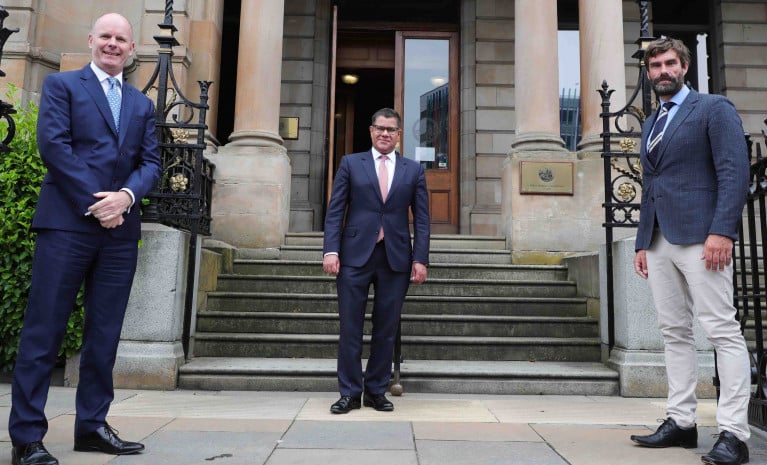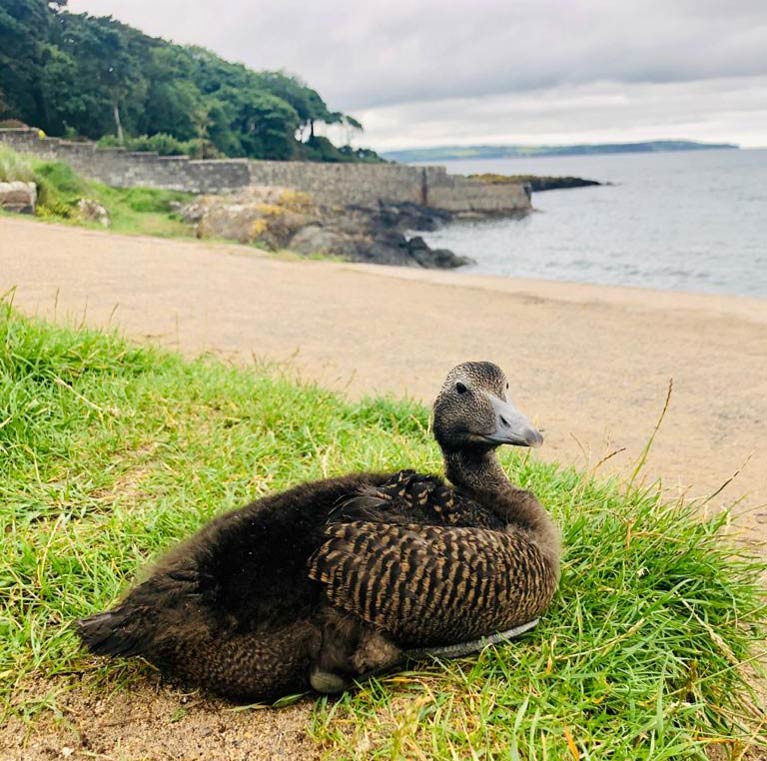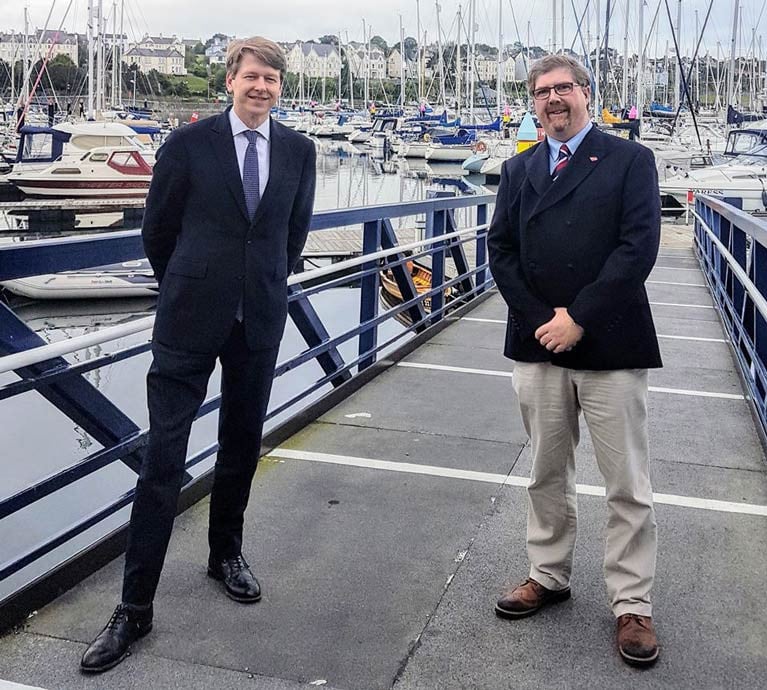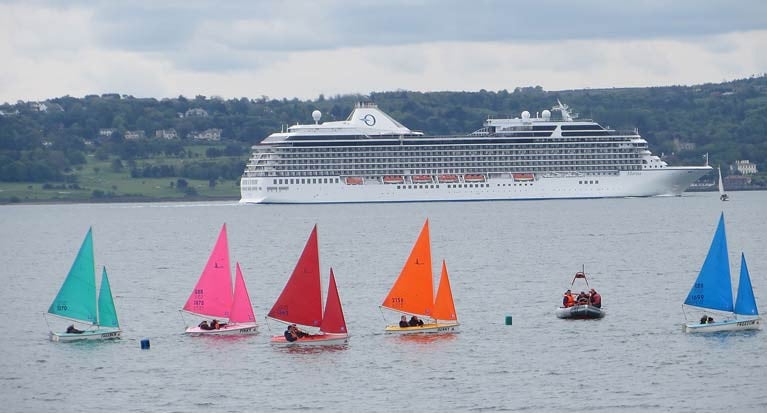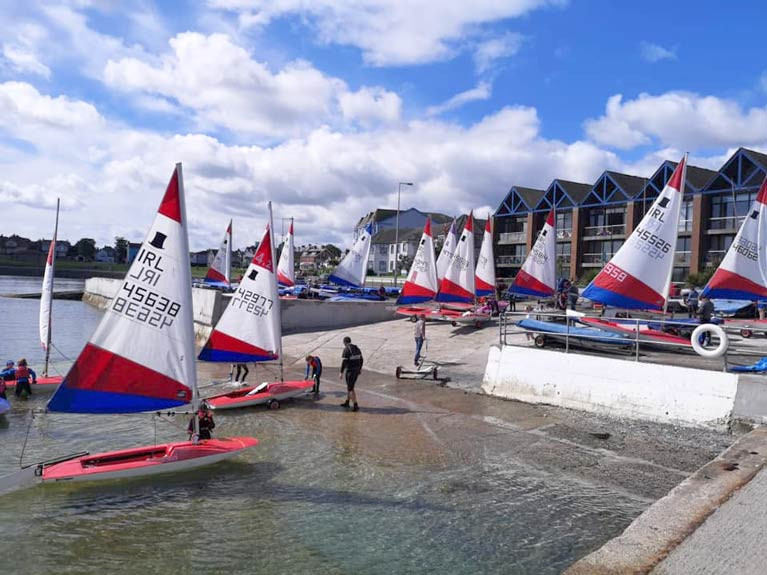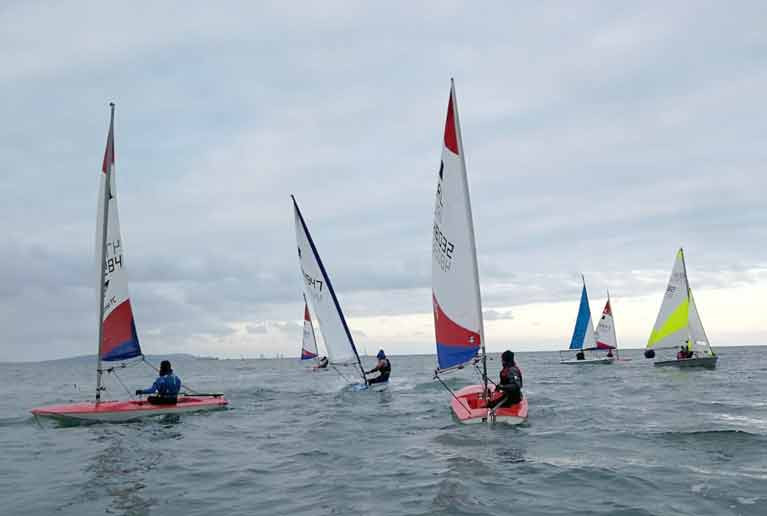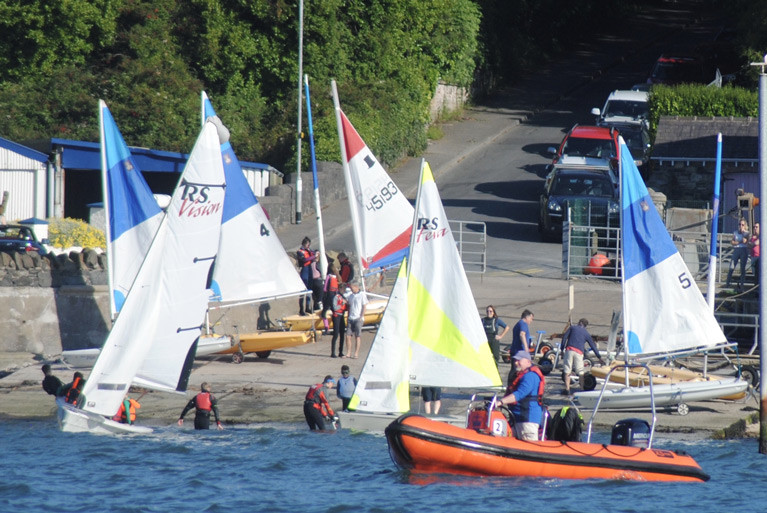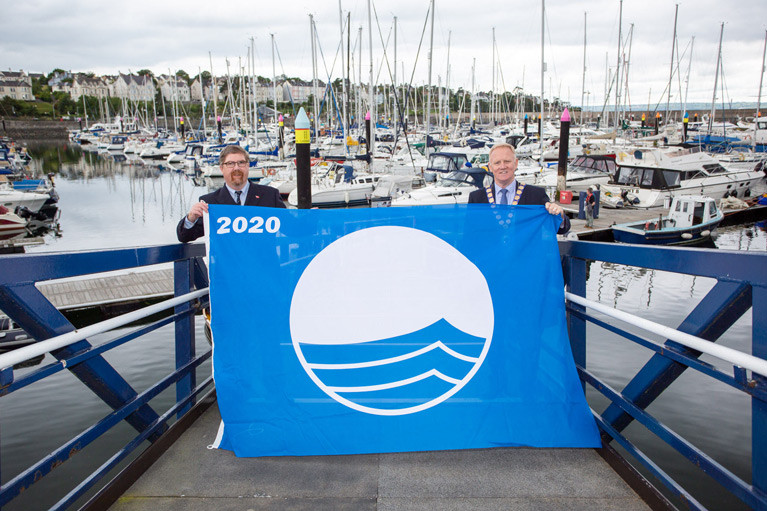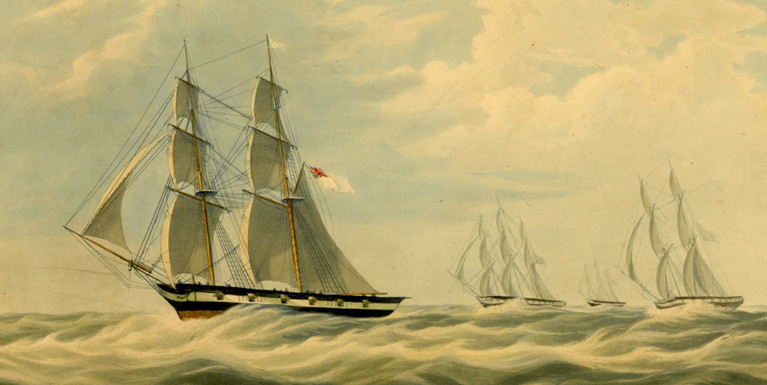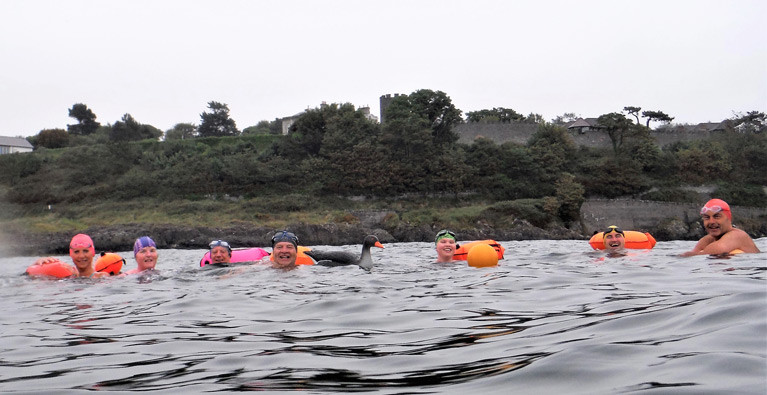Displaying items by tag: Belfast Lough
UK Business Minister Visits Belfast Maritime Consortium
The Belfast Maritime Consortium led by Artemis Technologies, has hosted a visit to the city by the Secretary of State for Business, Energy, and Industrial Strategy (BEIS), the Rt Hon Alok Sharma MP.
Representatives of the 13-partner syndicate met the minister to discuss their plans to develop zero-emissions ferries in Belfast that will revolutionise the future of maritime transport.
The project recently won a £33 million Strength in Places Fund grant from UK Research and Innovation (UKRI), a BEIS funded body
Iain Percy OBE, CEO of Artemis Technologies, a spin-off from competitive sailing team Artemis Racing, said:
“It was a pleasure to host the Secretary of State in Belfast to showcase our plans to make the city, and the UK, the global lead in zero emissions maritime technology.
“Along with our consortium partners, we took the opportunity to provide a detailed brief to the Minister on our plans to foster a newly resurgent maritime cluster in Northern Ireland that could create hundreds of jobs over the coming years.
“No matter who we meet, the excitement when we talk about combining Belfast’s shipbuilding heritage with its incredible talent in aerospace and composite engineering, and world-class R&D capabilities, is clear to see.
“Thanks to the support of BEIS and UKRI through the Strength in Places Fund, and with the assistance of our partners in industry, academia and the public sector, we can harness that potential and change the face of waterborne transport forever.”
During the visit, the Secretary of State met with members of the Belfast Maritime Consortium at Belfast Harbour, before previewing new exhibition space at the W5 interactive science museum featuring Artemis Racing’s America’s Cup high-speed yacht, and touring the Northern Ireland Advanced Composites and Engineering (NIACE) Centre, which will host part of the consortium’s R&D programme.
The Belfast Maritime Consortium project, which is being backed by close to £60m of investment over the next four years, including contributions from consortium partners will create an initial 125 research and development jobs leading to more than 1,000 in the region over the decade.
The Belfast consortium brings together a range of established and young firms, academia and public bodies, including Belfast Harbour, Bombardier Belfast, Northern Ireland Advanced Composites Engineering (NIACE), Creative Composites, Energia, Catalyst, Invest Northern Ireland, Ulster University, Belfast Met, Queen’s University, Belfast, Ards and North Down Borough Council, and Belfast City Council.
Another ‘Goose’ on the North Down Coast
Recently the Brompton inflatable goose featured in a story about open sea swimmers near Bangor on Belfast Lough. Now round the corner from Brompton, the Helen’s Baywatch swimmers have a real ‘Goose’ to swim with!
The reddish-brown female eider duck started life on Trasnagh Island in Strangford Lough where it was noticed five weeks ago by Jack Childs on a kayaking trip. He saw some dead ducklings but ‘Goose’ was still very much alive and hopped into his kayak.
Having unsuccessfully tried to return it to land he decided to keep it safe and ended up taking it home.
This special duck is ironically called ‘Goose’ after Tom Cruise’s wingman in the 1986 blockbuster, Topgun.
Jack and his mum Clare took advice from a friend who kept ducks and started it on the correct food. It thrived with all this individual attention and now thinks Clare and her son are his family! So much so it goes everywhere with them (in a cat carrier) and swims regularly with the group, not only in Helen’s Bay but also at other locations such as Donaghdee and Islandmagee. ‘Goose’ has even been in the Mourne Mountains!
Naval Ships & Minister Visit Bangor Marina on Belfast Lough
Bangor Marina on Belfast Lough had high profile visitors last week. Three naval ships, HMS Biter, HMS Charger and HMS Express docked at the marina. All are Archer class patrol and training vessels and attached to Universities in the North West of England. Biter is assigned to Manchester and Salford, Express to Wales University, and Charger to Liverpool University. And a few days before the armed patrol boat HMS Tracker docked in the Harbour.
A few days later the Marina welcomed Minister of State for Northern Ireland Robin Walker.
Ards and North Down Mayor, Councillor Trevor Cummings, Chief Executive Stephen Reid and Director of Regeneration, Development & Planning Susie McCullough, hosted a meeting with the Minister to discuss the opportunities offered by the Belfast Region City Deal and to view the Bangor seafront regeneration programme.
 Three naval ships, HMS Biter, HMS Charger and HMS Express docked at Bangor Marina
Three naval ships, HMS Biter, HMS Charger and HMS Express docked at Bangor Marina
Belfast Lough Sailablity Postpones President’s Cup
Belfast Lough Sailability was due to host the President’s Cup in August but sadly, due to COVID 19, this event has had to be postponed.
This interprovincial regatta was Inaugurated by Paralympian John Twomey, promoted by Sailability Ireland and provides anyone with a disability from the 32 counties of Ireland the opportunity to compete on the water and experience the joys of sailing.
Belfast Lough Sailability is based at Carrickfergus Marina and has a wide range of boats for everyone to enjoy but as it is impossible to socially distance while putting on buoyancy aids or lifejackets for people with disabilities, it is postponed until August 2021. As previously reported, the event was held at the Royal St George last year.
Secretary Anne Taylor says “We will be expecting to have at least 30 boats on the water and I will let you know if we do manage to get back on the water later this year”.
At Carrickfergus, the organisation welcomes group visits from schools and youth groups for children and young people with disabilities, and groups for adults with disabilities.
Ballyholme ‘Sharks’ Return to the Bay
The Cadets at Ballyholme Yacht Club in Bangor Co Down on Belfast Lough are split into two sections; the beginners called Dolphins and those who have completed Stage 3 – Sharks. In order to reduce the numbers on the slipway and afloat at any one time, the Sharks had their turn last Saturday.
After the much-delayed return to the water due to COVID, a great turnout of 18 Toppers enjoyed a perfect morning practising racing in two groups.
In charge were RYA club coaches Colin Robinson and Andrew Dadley with RYA Instructor Russell Finlay and the safety boat was manned socially distanced by John Bell and Coach David Nelson on board.
Full Steam Ahead for Sailing in Bangor on Belfast Lough
Neighbouring clubs Royal Ulster and Ballyholme at Bangor in County Down on Belfast Lough are both due back on the water soon.
The RUYC sailing committee has decided that in line with further guidance from the RYA that competitive sport can’t start until the 17th July at the earliest, that the club will start sailing on the Saturday 18th July in the first of a series of Round Belfast Lough type courses. In August a new one round the Copeland Islands is planned. The updated sailing programme and sailing instructions for the new series of races will be available here www.ruyc.co.uk on 10th July.
Thursday night racing has been cancelled for this month (July) but as events are moving very quickly now, the August points racing will be reviewed should there be a further easement. The annual Regatta will now not be possible this Saturday (11th) as competitive sailing cannot happen until later in the month. It is hoped that a smaller-scale event will be held during September.
Short cruises in company around Belfast Lough are on the books with a start this Sunday (12th) with a short trip to Helens Bay where anchoring is possible.
Sailing Secretary Jim Coffey said “The sailing committee would like to thank members for their patience and understanding whilst we try and work our way through these difficult times; ultimately the safety of members is paramount as the pandemic is still with us".
At Ballyholme the bar will open this evening (9th)with drinks served outside with the now usual restrictions. See Ballyholme.com
And there is good news for cadets. Paul Prentice RTC (Recognised Training Centre) Principal is delighted to be able to run courses. “ Thanks to our dedicated training team, with support from RYANI, we are delighted to release our Programme for 2020”. He adds “ As you will see there are a number of changes to the format, and unfortunately, due to restrictions we are unable to offer beginners courses.
The team is excited to welcome you back on the water”.
Courses are available to book, for Members only until Friday 17th July, after which they will be opened to non-members. Please take some time to read the information online and particularly the cancellation policy and ifIf you have any questions or concerns, please give Lyn a call at the club on 028 9127 1467.
Cadet Summer Sailing at the Royal North of Ireland Yacht Club on Belfast Lough is proving popular with much interest in the scheme which starts on Monday next (13th July).
Rear Commodore Sailing Jonny Millar, Cadet Officers John Driscoll and Gillian Killiner and the Hon Sailing Secretary Denis Todd have put together an attractive though restricted programme for the children.
Due to the current COVID 19 restrictions the sailing will run in a new format in order to get the Cadets on the water and remain safely within current guidance. There will be no access to the changing rooms, or any other rooms inside the clubhouse. This makes it impossible to run the usual RYA course structure. The new format will simply focus on getting children out sailing, improving their skills and confidence on the water.
Morning or afternoon sailing sessions will be bookable in fortnightly or weekly blocks. Morning sessions are for those looking to improve their sailing skills, afternoons for Cadets looking to start or improve their racing. These active sessions will be run by RYA qualified Senior and Dinghy Instructors. There will be no inside classroom sessions, just more time on the water! Group sizes will be limited and consequently, overall capacity is reduced.
Unfortunately, the restrictions do not allow shared boats or the close contact with instructors needed to run beginners’ courses. All sailors taking part will be sailing single-handedly. As the club is aware many younger Cadets want to learn to sail this situation will be kept under close review.
Online booking is open here
Rear Commodore House Lindsay Nolan says, “The new format is different to our usual, but the changes allow us to remain within current guidance and get some Cadet sailing. We look forward to seeing our Cadets on the water again this summer”.
The Ards and North Down coastal area has done well by winning awards for excellence in facilities, environmental management, environmental education, accessibility and safety.
Bangor Marina has been awarded the internationally renowned Blue Flag for the 2020 season. The Blue Flag award is certified by the Foundation for Environmental Education (FEE) and is delivered in 47 participating countries.
The beaches at Ballywalter, Cloughey, Groomsport and Millisle, managed by Ards and North Down Borough Council, along with Crawfordsburn beach, which is operated by Northern Ireland Environment Agency, have received the prestigious Seaside Award. The Seaside Award is the national standard for beaches across the UK. This programme ensures visitors of a clean, safe, attractive, and well-managed beach with the facilities provided being appropriate for the location of the beach. Helens Bay, also operated by Northern Ireland Environment Agency received a Green Coast Award, which recognises an agreement between the operator and the local community to protect and promote a natural beach. Green Coast Award beaches can also be found in the Republic of Ireland and in Wales, but due to their more natural state, may not be flying a flag.
 Helens Bay Beach in Bangor received a Green Coast Award
Helens Bay Beach in Bangor received a Green Coast Award
Mayor of Ards and North Down, Councillor Trevor Cummings commented: "Our borough encompasses the southern shore of Belfast Lough, the Irish Sea coast and most of the perimeter of Strangford Lough, giving us 115 miles of stunning coastline. It is fantastic that so many of our beautiful seaside locations have been recognised in this year's Beach and Marina awards. It is a fitting tribute to the work of both the Council employees and the many groups of volunteers who together strive to keep our coastline clean, tidy and welcoming for visitors.
Dr. Ian Humphreys, CEO of Keep Northern Ireland Beautiful, stated: "We are delighted to see the high standards at so many of our local beaches continuing into 2020. Our fantastic beaches are an important part of the natural wealth that we can all enjoy as a community. This summer, it is important to follow guidance from the public health authorities around social distancing when visiting local beaches. Furthermore, it is up to all of us to ensure that we leave these beauty spots in good condition. I am appealing to everyone to make sure that they leave no trace on our local beaches by putting litter in the bin."
In the current wave of revulsion against slavery and its appalling history, no European nation has totally clean hands. For although we might like to think that the huge Caribbean sugar plantations worked by African slaves in the 1800s brought tainted wealth mainly to cities such as Bristol, Liverpool, Glasgow and London in Great Britain, with Ireland largely uninvolved, when slavery itself was finally abolished in the British Empire in 1833 (the Slave Trade having been banned since 1807), all the slave owners were generously recompensed for the loss of their “property”, and a number of them proved to have Irish addresses.
Not that slavery was anything new in Ireland. It was an integral part of the ancient Gaelic economy and culture, and after the Vikings had taken over the little settlement of Baile Atha Cliath in the delta marshes of the River Liffey and turned it into the thriving port and trading hub of Dublin, it quickly reached the decidedly dubious peak around 1000AD of being Europe’s largest slave-trading centre. Captive Irish men and women were sold into a life of complete drudgery in every corner of the Viking Empire, which means that DNA tests can reveal the sometimes significant presence of Irish genes in some remarkably remote places where the longships once prowled.
 The 100ft Viking ship Sea Stallion may symbolise the freedom of the seas for her rugged crew. But when the original was built in Dublin a thousand years ago of timber from Glendalough, its Norse rulers had made the port the largest slave-trading centre in their widespread empire, and possibly in the entire world
The 100ft Viking ship Sea Stallion may symbolise the freedom of the seas for her rugged crew. But when the original was built in Dublin a thousand years ago of timber from Glendalough, its Norse rulers had made the port the largest slave-trading centre in their widespread empire, and possibly in the entire world
But while the Dublin slave trading of a thousand years ago was on a then-epic scale, it was decidedly modest by comparison with the Transatlantic trade from West Africa from the 1500s onwards, which was started by the Portuguese, the Spaniards and the Dutch, but was then dominated the by the British and turned into people transport – in worse conditions than cattle - on an industrial scale involving millions of human beings.
The perverted ingenuity which went in making the slave ships both efficient and fast meant that the authorities faced an enormous challenge in trying to stamp out the trade after 1807, but once the slavery itself was officially abolished in 1833, those involved in eradicating it were encouraged by having a real chance of reducing the pernicious business. And what they needed more than anything else to continue eradication was fast and nimble warships, for the slaveships – the “blackbirders” - were masterpieces of twisted ingenuity in their superb all round performance and speed, and catching and arresting them required high-speed manoeuvrable sailing warships.
This is where the Earl of Belfast (1797-1883) and his 334-ton brig-rigged “yacht” Waterwitch of 1828 come into the story. Lord Belfast was the heir to the Marquess of Donegall, whose family the Chichesters had done well out of an ancestor, Arthur Chichester, Lord Deputy of Ireland from 1605 to 1615, whose international mercenary experience stood him to good stead in the war-making and conquest aspects of his new official position in Ireland.
In fact, Chichester (whose extended family from North Devon later included pioneer aviator and yacht voyager Francis Chichester) was too successful for his own good in taking over control of vast swatches of south Antrim and East Donegal and other areas, as well as playing a significant role - as the new landowner and charter-holder of Belfast - in turning it from a tiny lough-head village into the makings of a major port, and a commercial and industrial centre of eventually global significance.
 Arthur Chichester was effectively the founder of Belfast, but though he was successful as a warlike land-grabber, he was not so good at land management, and his financial abilities were woeful
Arthur Chichester was effectively the founder of Belfast, but though he was successful as a warlike land-grabber, he was not so good at land management, and his financial abilities were woeful
For all was not as it seems. Because he’d acquired control over so much land, Chichester had to outsource most of its management to middlemen as he went on to handle other challenges at home and abroad where his military expertise flourished, and as a result, the family seem to have been almost constantly in financial difficulties.
But as was said of the banks and other large enterprises during the economic crash of 2008, the vast and rambling Chichester empire in Ulster was simply too large to fail, and though the land-grabbed rural tenantry in Country Antrim and Donegal, and the industrious rate-paying citizens of the rapidly-growing Belfast, will have had mixed feelings about their strictly-enforced payments pouring into what seemed at a times like a financial black hole, outwardly at least the Chichesters were flying, with Sir Arthur Chichester’s descendants on an upwards trajectory which reached its peak when the head of the family became the Marquess of Donegall, while his son and heir was the Earl of Belfast, their family’s rise and importance being underlined by the rapidly-growing Belfast including Chichester Street, Donegall Place, and Donegall Avenue in its expanding layout.
Yet while their outwards links to the city and other extensive properties in the north of Ireland appeared strong – including the 1830s Earl of Belfast being Westminster MP for Carrickfergus and Belfast and an important figure at the royal court in London - there were new links through marriage to County Wexford, where Dunbrody House (now Kevin Dundon’s renowned gastro-hotel) was to become a later Marquess of Donegall’s main residence, and indeed the family still live nearby.
 The Earl of Belfast (1797-1883) was an exceptionally good judge of yacht and sail design, but his high level of enthusiasm for the sport didn’t help his perilous finances
The Earl of Belfast (1797-1883) was an exceptionally good judge of yacht and sail design, but his high level of enthusiasm for the sport didn’t help his perilous finances
But the Earl of Belfast of the 1820s and ’30s preferred if at all possible to spend his time in his house in Cowes when not on parliamentary or royal duties in London, for he was mad keen on sailing, an enthusiastic and active member of the recently-formed (1815) Royal Yacht Squadron, and his preferred personal company was with the leading local ship-builder Joseph Samuel White whose family firm had been founded way back in 1694 and continued to build boats yachts and ship until 1974, while the third member of this intriguing and innovative triumvirate was George Ratsey, an early light in the stellar formation which was to become the distinguished Ratsey family, who were noted also for boat-building talents, but became world-beaters in sail-making.
In the 1820s Lord Belfast’s two specialists created him a special racing yacht with the cutter Harriet, which was so successful that his Lordship announced that, having done all he could with fore-and-aft rig, he would in the 1830s turn his attention to square rig with the philanthropic intention of helping to improve the sailing qualities of the ships of the Royal Navy by competition and example.
 The racing cutter Harriet with which the Earl of Belfast first made his mark in the 1820s
The racing cutter Harriet with which the Earl of Belfast first made his mark in the 1820s
Joseph White built this 334-ton two-masted brig-rigged ship Waterwitch in Cowes in 1832, while George Ratsey set-to in his lofts nearby to create the finest racing sails money could buy, even if - in the case of the Earl of Belfast - it was all money which came very much under the “future earnings” category, with much of it resulting in time from the sweat off the backs of small farmers in Antrim and Donegal.
Although she had the outward look of a superyacht of the 1830s (had such a term then existed), the Earl of Belfast kept her sparsely fitted in basic navy style, and set about arranging a match against the best navy vessels. Yet the Royal Navy were oddly unenthusiastic about being publicly shown up by such a contest, for by now Lord Belfast had even given his brig a marked naval-style black-and-white stripe along where the gunports were located.
 On every point of sailing, Wayerwotch out-performed the crack vessels of the Royal Navy’s Channel Squadron
On every point of sailing, Wayerwotch out-performed the crack vessels of the Royal Navy’s Channel Squadron
So eventually in exasperation, in 1834 and with the marine painter William John Huggins on hand to record the scene, he sailed the Waterwitch in close company on all points of sailing with the crack Royal Navy Channel Squadron as it made its regular parade of power and sea speed between Dover and the Isles of Scilly, and on every point of sailing and in all strengths of wind, Waterwitch was comfortably the top performer.
But despite a press clamour and public campaign, for a while, the naval authorities behaved as though it had never happened, so in exasperation, Lord Belfast spent more of other people’s money in making Waterwitch more of a yacht, and he won a hundred guineas of it back again after winning a close-fought challenge match race in early September 1834 to the Eddystone Lighthouse and back against the hottest big racing yacht of the day, the schooner Galatea.
It was this match challenge which finally seems to have spurred the Navy to action. The Earl of Belfast may have hoped that the Royal Navy would have been inspired to build their new ships as larger versions of Waterwitch, and to use George Ratsey more extensively as their sailmaker or at least a sailmaking consultant, and in this, he was partially successful. But in a sense, they side-stepped the issue by simply buying the Waterwitch, and almost immediately dispatching her to join the West Africa Squadron where she was seen as ideal for a slave-ship chasing role.
 In the Hundred Guinea Match of September 1834, the schooner Galatea may have been first away, but Wayerwitch (left, and now modified back to yacht style) was to win
In the Hundred Guinea Match of September 1834, the schooner Galatea may have been first away, but Wayerwitch (left, and now modified back to yacht style) was to win
The flyer of Cowes was not even given the distinction of being made HMS – the navy men were rigid in their approach to this cheeky vessel which had so distinctly shown them up, and throughout her successful time with the Royal Navy she was always HMB – Her Majesty’s Brig Waterwitch.
In its latter days, the final elimination of the West African slave trade was possibly the most demanding phase of all, and until she was taken off the station in 1843, HMB Waterwitch played a key role in freeing more than 25,000 slaves. It was appalling work, as the fast little ship had to overcome the slavers and then put a delivery crew aboard the captured vessel to sail it to some port where the tragic cargo could be humanely dealt with.
The Squadron’s base was at the remote island of St Helena, and the placing of crews on slave ships often meant she returned to the island’s open roadstead with barely enough crew to handle the ship and further burdened with the knowledge that disease was so rife that they would see few enough of their shipmates again.
But in the tiny community on St Helena, they always received a warm and supportive welcome as the most successful slave-trader hunting ship of all, and a Vice-Admiralty Court on the island from 1840 until 1872 meant that those slave-running prisoners with whom they’d returned could be dealt with properly through internationally-recognised law.
So important was the St Helena link to Waterwitch’s crew that when her duties there were concluded, the impressive Waterwitch Memorial was erected in a pleasant spot on the island. Its inscription reads:
“This column was erected by the commander, officers and crew of Her Majesty’s Brig Waterwitch to the memory of their shipmates who died while serving on the coast of Africa AD 1835-1843. The greatest number died while absent on captured slave vessels. Their remains were either left in different parts of Africa or given to the sea, their graves alike undistinguished. This Island is selected for the record because three lies buried here and because the deceased, as well as their surviving comrades, ever met the warmest welcome from its inhabitants”.
The Earl of Belfast’s very special brig was to survive until 1861 when – tired by her exertion in hostile climates, and out-dated by the arrival of steam vessels - she was quietly broken up. As for his Lordship, he and his father the Marquess of Donegall ran out of road for a while in the 1840s, and they were jointly brought to bankruptcy for 400,000 pounds, which would be squillions today.
But all was not lost. Belfast – then still a town, though a rapidly growing one rising prosperity – was sold out from under them to pay their debts, ad that was one problem solved. Then the Wexford connection injected new resources, and on they went, with the Waterwitch Earl of Belfast – now the Marquess of Donegall – reported as having died in his beloved Cowes in 1883.
It’s a decidedly mixed story. Nevertheless, in the mood of the moment, is it inappropriate to suggest that this might be the time for a second Waterwitch Memorial, this time in Belfast City Hall?
 The Waterwitch Memorial on St Helena recalls a special Belfast link to suppression of the international slave trade
The Waterwitch Memorial on St Helena recalls a special Belfast link to suppression of the international slave trade
This article was first published 7th July 2020
The Brompton Goose & Sea Swimming on Belfast Lough
Northern Ireland’s coastline is dotted with cold water swimmers who go out no matter what the weather or temperature. The group who swim near Jenny Watts Cave just past Wilson’s Point at Bangor on Belfast Lough are known as the Brompton Belles and Beaux Dippers, taking their name from the nearby road.
Using a decoy Goose as a turning mark was the idea of Nicola Woods who thought it would make a fun swim buoy. Not only is it great fun and a talking point, but from a safety perspective, it is positioned 150m round the reef. Swimmers can use this as a marker and slowly build up to swimming the 300m round the Goose.
Brompton Belles and Beaux Dippers was set up by Marie-Thérèse Davis-Hanson in 2017. Her objective was to establish a group so that anyone who wanted to swim could connect with a swim buddy and not swim alone. Safety of the swimmers is paramount and for this reason, the group offer advice and guidance for anyone thinking of trying open water swimming.
 The Jenny Watts Cave
The Jenny Watts Cave
The rig was put together by Stephen Hanson and Paul Zund and put in position by Nicola, Stephen and Paul on 24th June 2020. (Paul’s other quite different interest is motor boating and he has a Sea Ray in Bangor Marina). The Goose has been causing a stir since then – in a positive way. Nicola says that she has some smaller ducks that she has plans for, so watch this space. Hopefully, the Goose will survive the next big North Westerly.
The group now has over 450 members and regularly participates in activities to raise money for charity, particularly Motor Neurone Disease Association as Marie-Thérèse’s brother has MND.
An interesting feature of the coast where the Brompton group swim is the Jenny Watts Cave. A local legend tells the tale of a local girl of that name who hid in the cave at low tide but was drowned when the tide came in. Her name lives on at the popular pub in High Street.
Safety is the main consideration for the Dippers and each swimmer always goes out at their own risk and is responsible for their own safety at all times. Tow-floats are advisable as the waters are often busy with boats, kayaks, yachts, lobster boats and paddleboarders. A brightly coloured swim hat and is also recommended as are post-swim hot drinks!


























